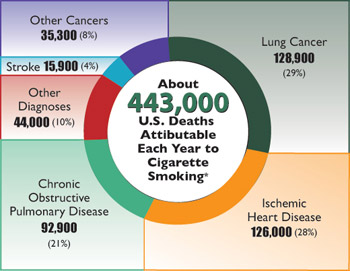Smoking, who needs it?

This problem is as close as the nearest cigarette vending machine. Tobacco use among the young is on the rise, with a particular increase in new smokers who are aged 13-14 years.
Studies confirm that the largest increase is in young females. Why?
It seems that today young women are taking up smoking for a number of reasons. Some of those reasons are linked to seeing actresses, models and other idols with a cigarette in their hand. Unfortunately, smoking has come to be once again viewed as a sleek or sexy accessory. Having a cigarette in one's hand appears to be cool, mature or fashionable. Why? How can breathing poisonous chemicals into ones lungs be sexy and mature?
Today alone, approximately 3,000 children and young adults under 18 will begin smoking. Frighteningly, with easy access to cigarettes and other tobacco products, this age group buys over 500 million packs of cigarettes each year. Scary!
Experimenting with tobacco in adolescence can have serious consequences. Some youth establish smoking patterns that can lead to nicotine addiction. Three quarters of these youth are increasing their risk of developing life-long and life-threatening smoking-related health problems. Most long time smokers begin using tobacco before they turn 18. Horrifying data indicates that about one in three young people who begin smoking in adolescence will die from a smoking-related disease.
So what's in a cigarette? Over 4000 different TOXIC chemicals', of which 43 are known to be carcinogenic (cause Cancer). Here are some of the chemicals that we often here most about:
- Nicotine: the drug in tobacco smoke that causes addiction among smokers. The strength of addiction is said to be as powerful or more so than that of heroin. Nicotine is a poison. Did you know that swallowing one drop of pure nicotine could kill an adult?
Photo Credit by http://www.DaVinciVaporizer.com
- Carbon Monoxide: is a colourless, odourless and very toxic gas. It is taken up more readily by the lungs than oxygen. High levels of carbon monoxide in the blood is typical of smokers and, together with nicotine, increases the risk of heart disease, hardening of the arteries and other circulatory problems.
- Tar: When a cigarette burns, tar is released. Tar is the main cause of lung and throat cancer in smokers. Smoking one cigarette immediately raises a person's blood pressure and heart rate and decreases the blood flow to body parts like the fingers and toes. The person's brain and nervous system activity is stimulated for a short time and then reduced and a smoker may also experience dizziness, nausea, watery eyes and acid in the stomach. Additionally appetite, taste and smell are weakened.
Other effects of smoking are typically shortness of breath, persistent coughs, reduced fitness, yellow stains on fingers and teeth and decreased sense of taste and smell. Often smokers will have more colds and flu's and will in general, find it harder to recover from other illnesses.
Smokers will often have far more wrinkles than someone the same age that does not smoke.
Smokers have an increased risk of developing: respiratory infections such as pneumonia and chronic bronchitis; emphysema which is a progressive and potentially fatal lung disease; heart attack and coronary disease; cancer of the lung, throat, mouth, bladder, kidney, pancreas, cervix, stomach; stomach ulcers; and peripheral vascular disease due to decreased blood flow to the legs. A person who is dependent on cigarettes may find that they experience withdrawal symptoms when they cut down or stop smoking cigarettes. These can include increased nervousness and tension, agitation, loss of concentration, changes to sleep patterns, headaches, coughs and cravings. If you are silly enough to not care about what smoking may be doing to you and your body then at least spare some concern for those around you.
Other dangers and important facts to take note of are: smoking during pregnancy can affect the unborn child and babies are more likely to be born underweight, premature or stillborn. Passive smoking, where a person is subject to breathing in the cigarette smoke of others, can cause lung damage, including cancer and heart disease. Fifty Australians die every day from smoking compared to ten who die from alcohol related diseases or four who die from road accidents.
The good news is that immediate benefits can be had from quitting now! Taste buds will come alive and sense of smell will improve. Breath, hair, fingers, teeth and clothes will look and smell cleaner. Within three months, blood flow to the hands and feet improves.
After twelve months the risk of cancer and heart disease is reduced.
Here are some more reasons why to quit (or never start in the first place!)
- Someone who starts smoking at 16, who is now 30 and has a 20 cigarette-a-day habit, has already inhaled A KILO of tar into her/his lungs!
- Tobacco smoke contains more than 4000 toxic chemicals. 40 of these chemicals are known to cause cancer!
- Women who smoke take longer to conceive and are more likely to miscarry a pregnancy.
- Every week, 350 Australians die as a result of tobacco related disease.
To get help: call the quit line : 13 18 48
Or Talk to your Doctor.
- Michelle Palmer
Also see article on Natural Quit Smoking Remedies
MORE





